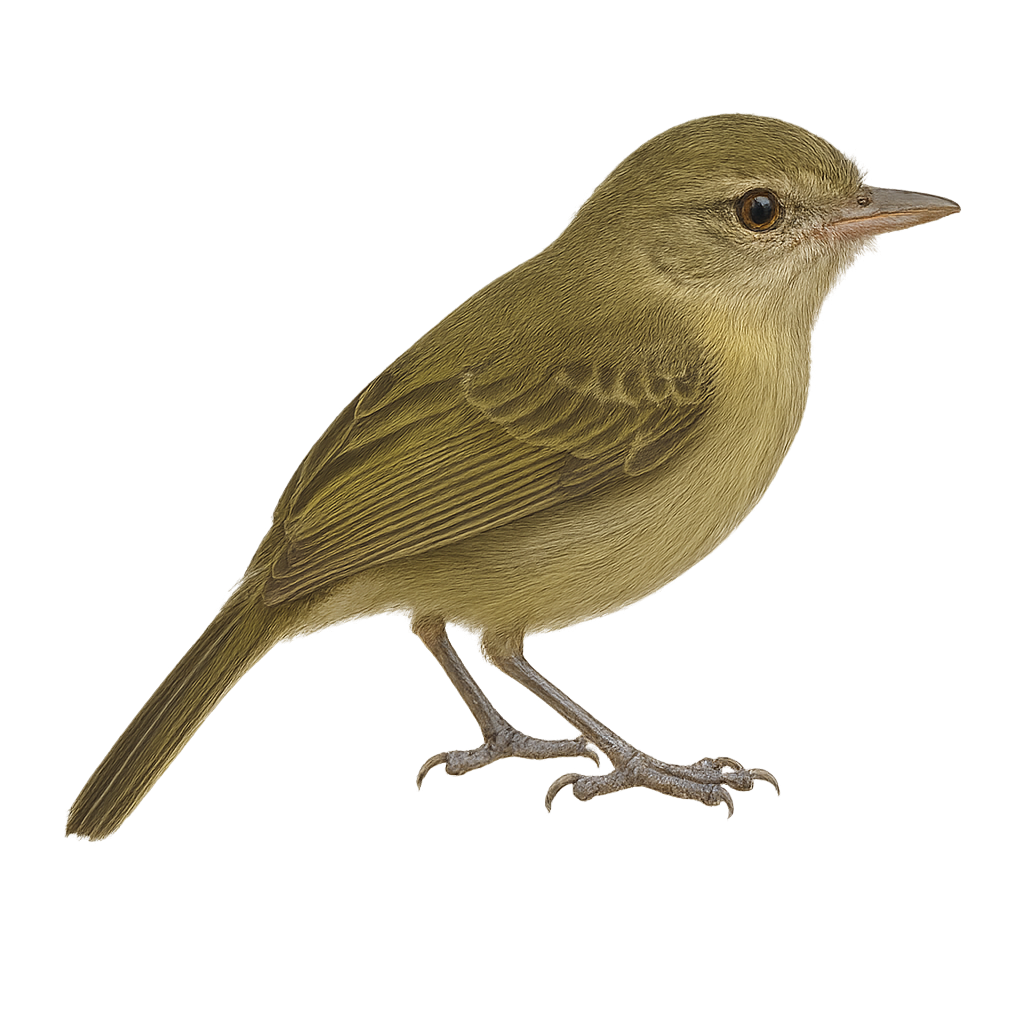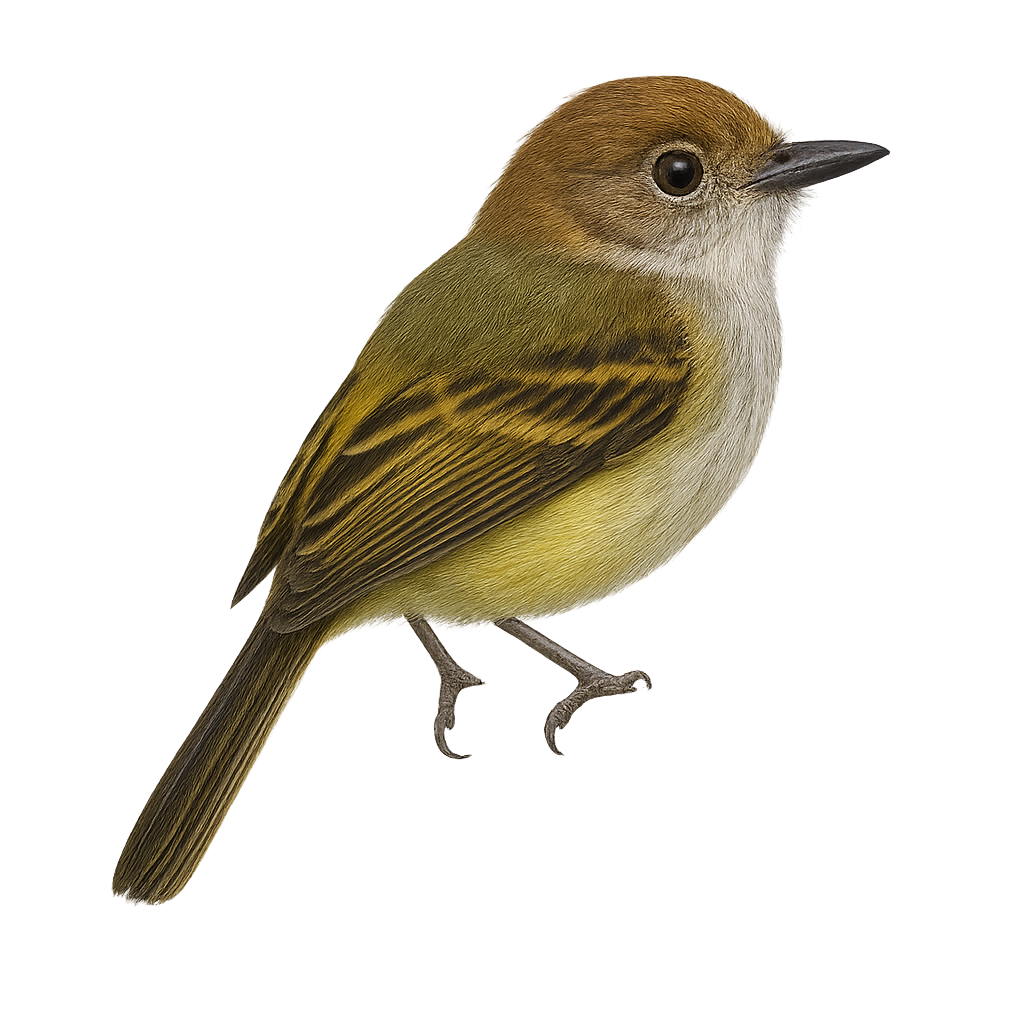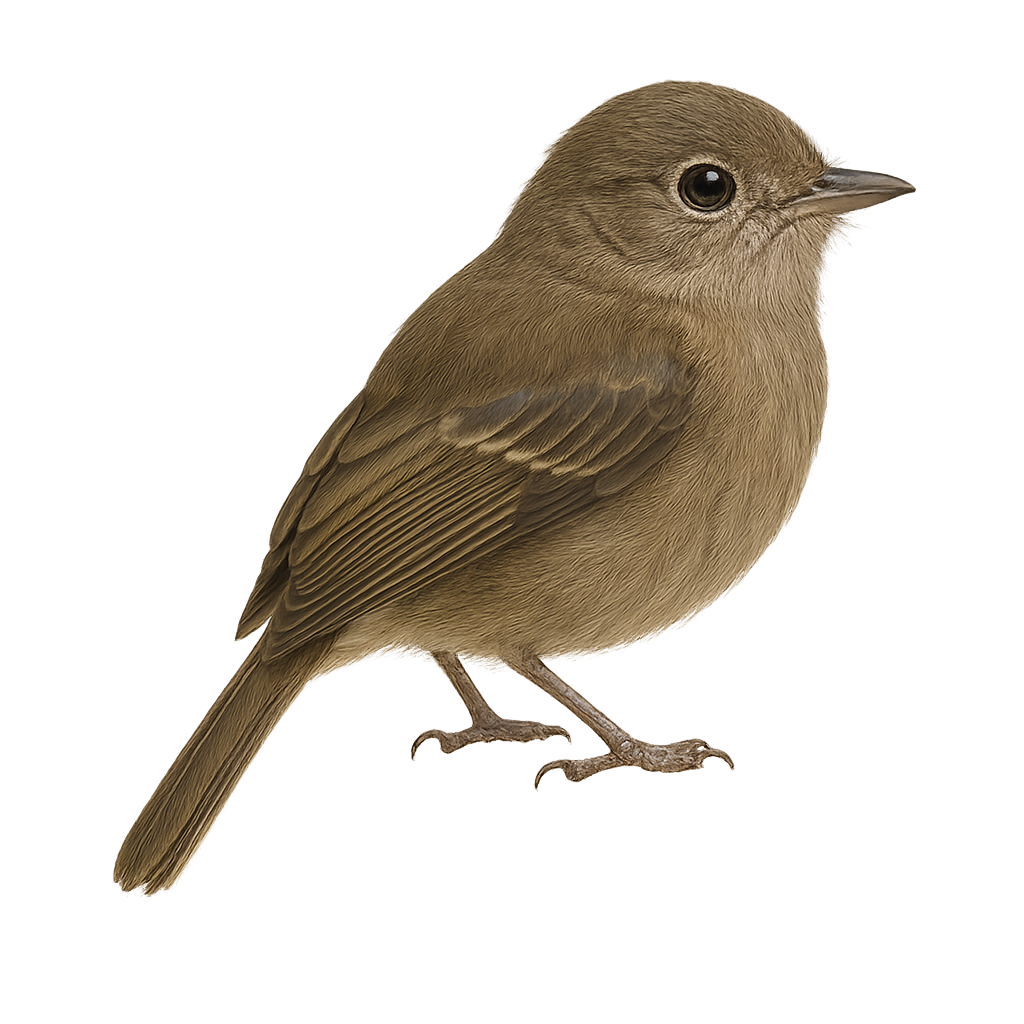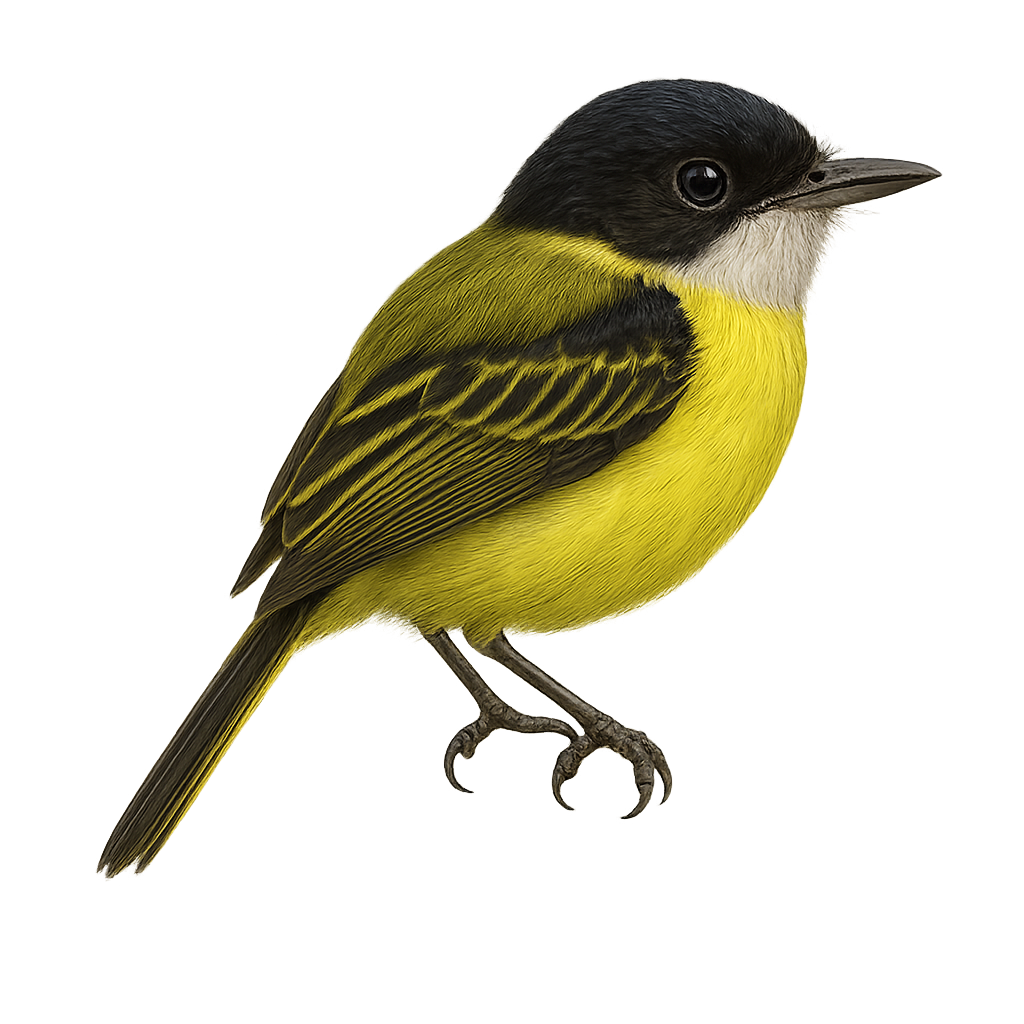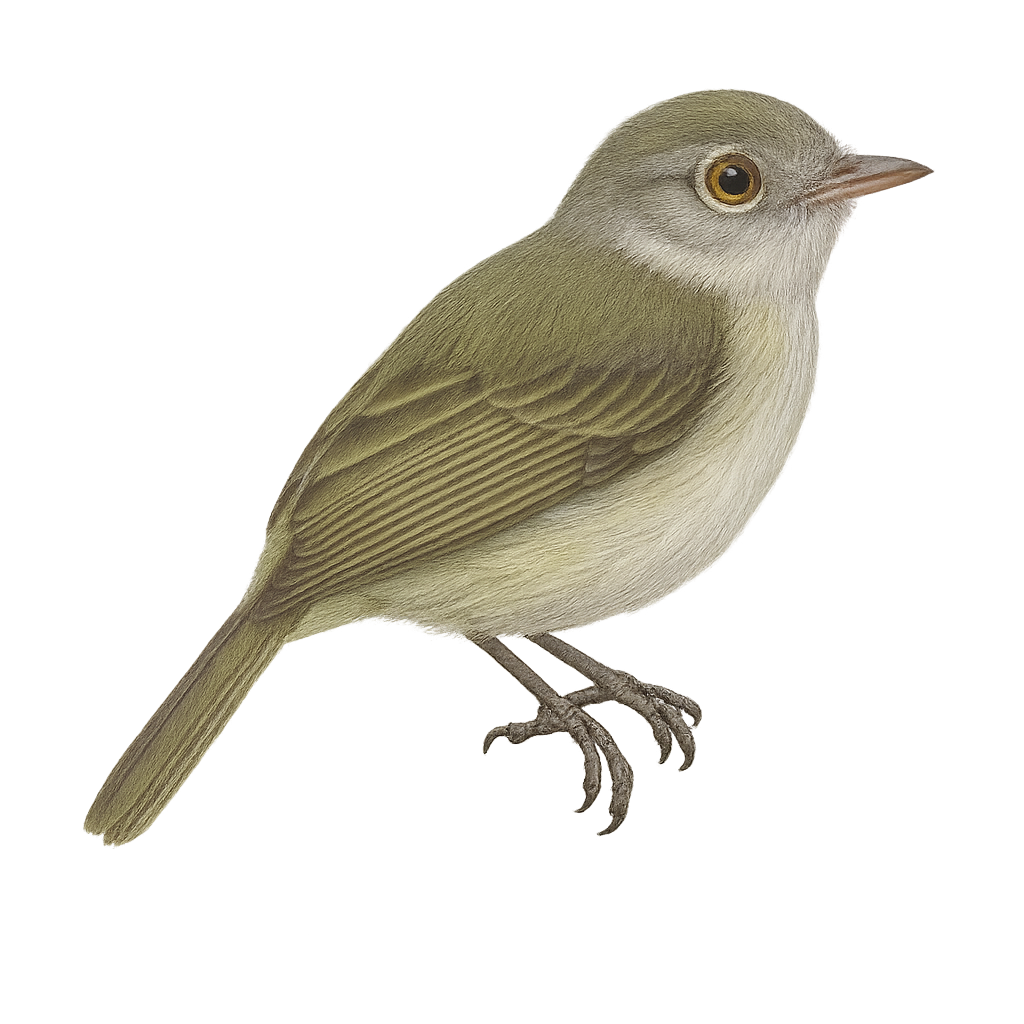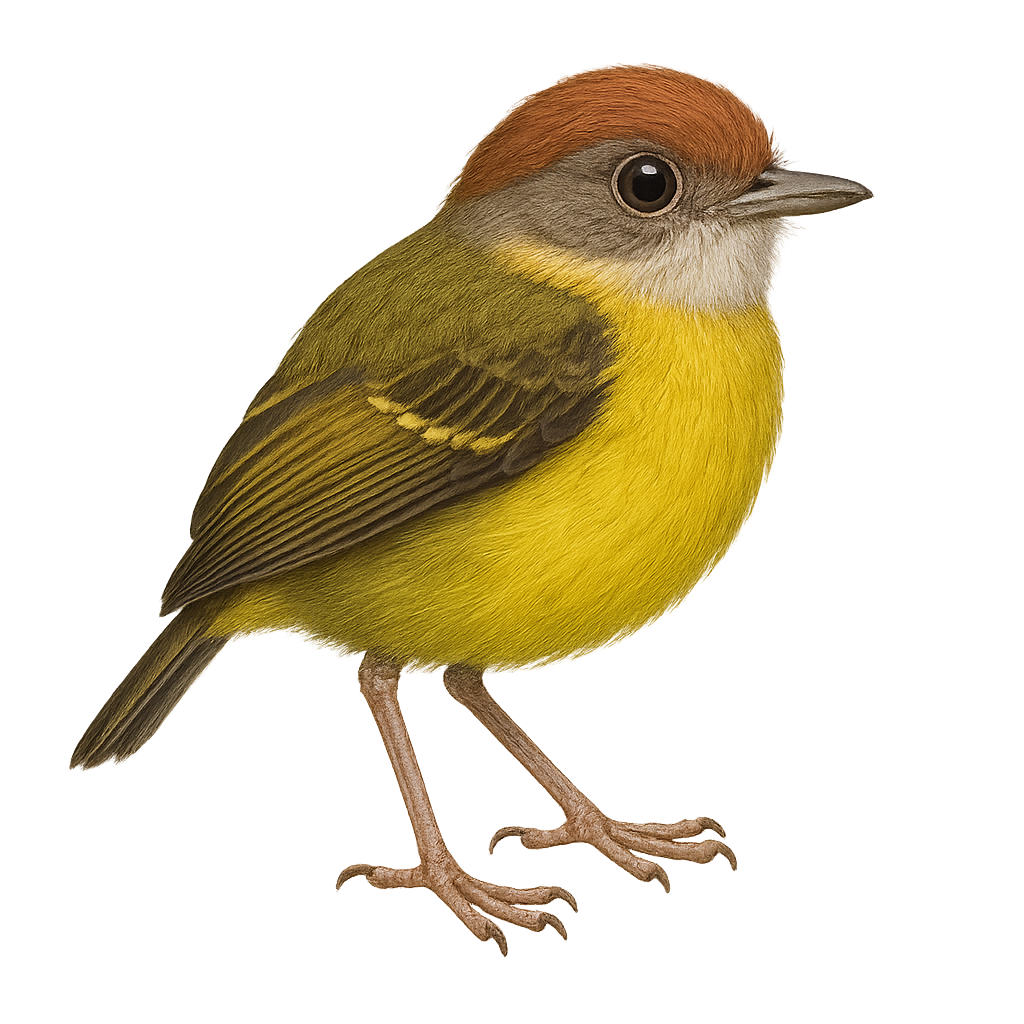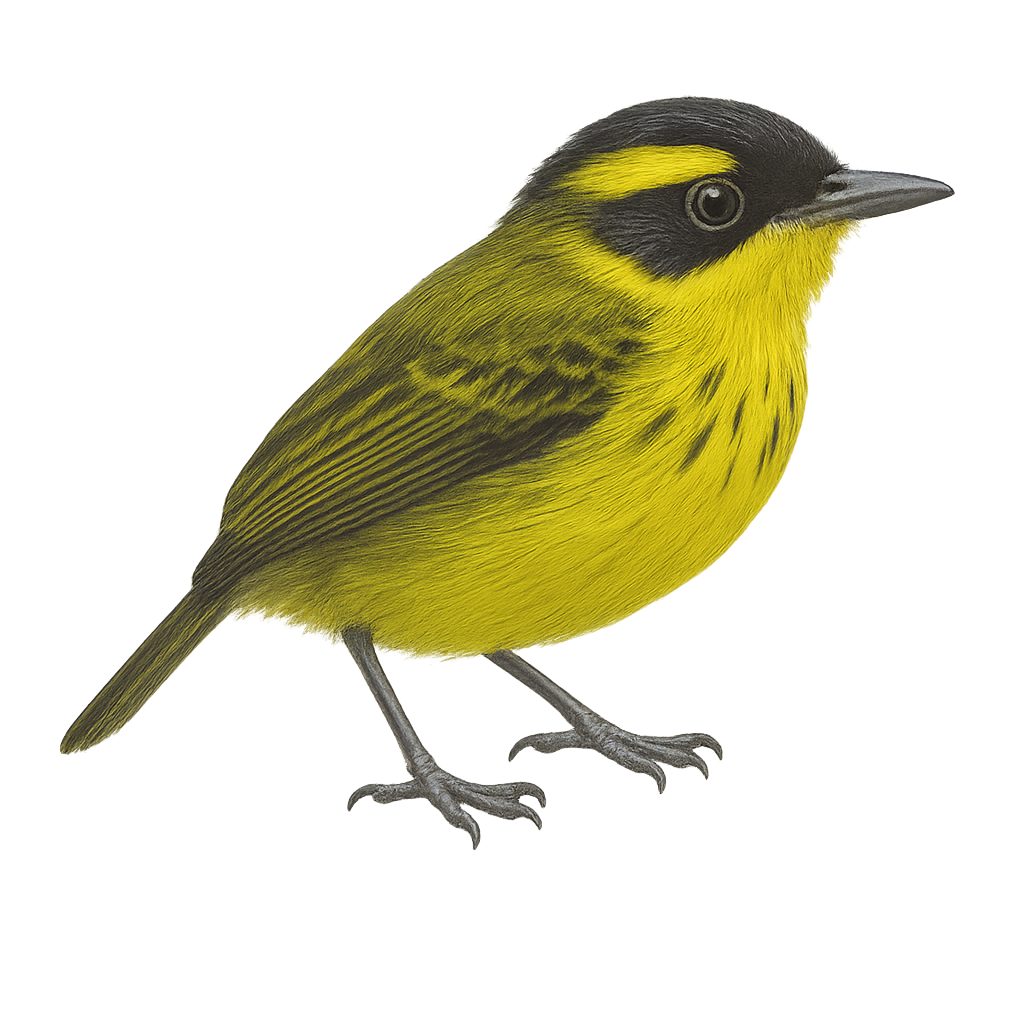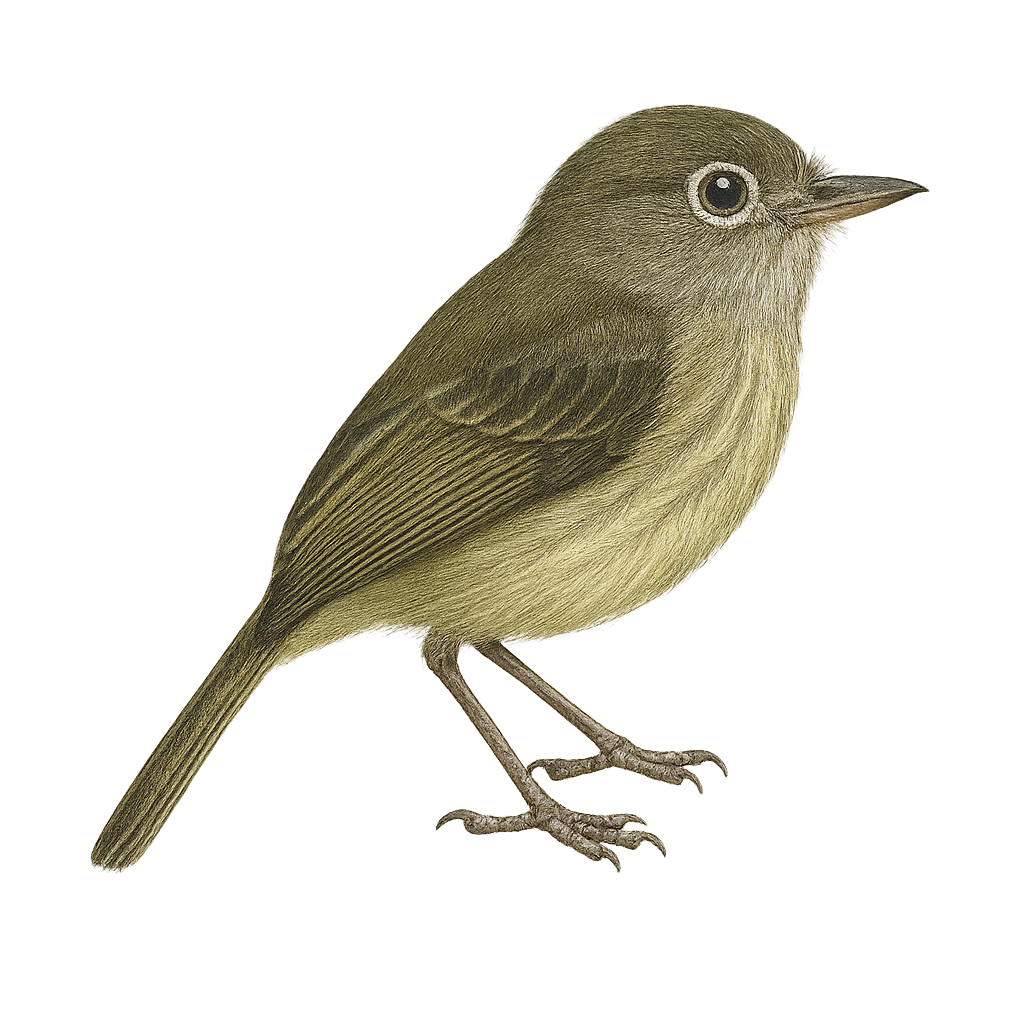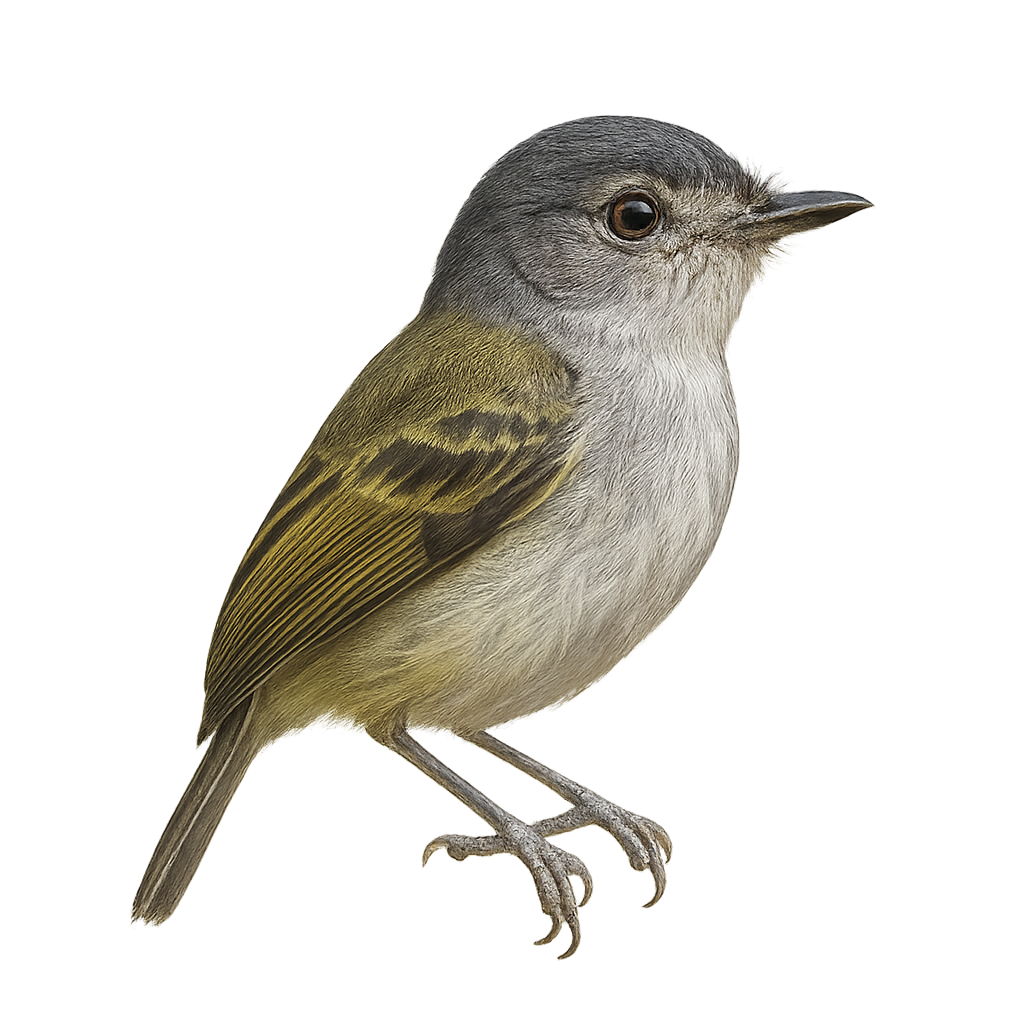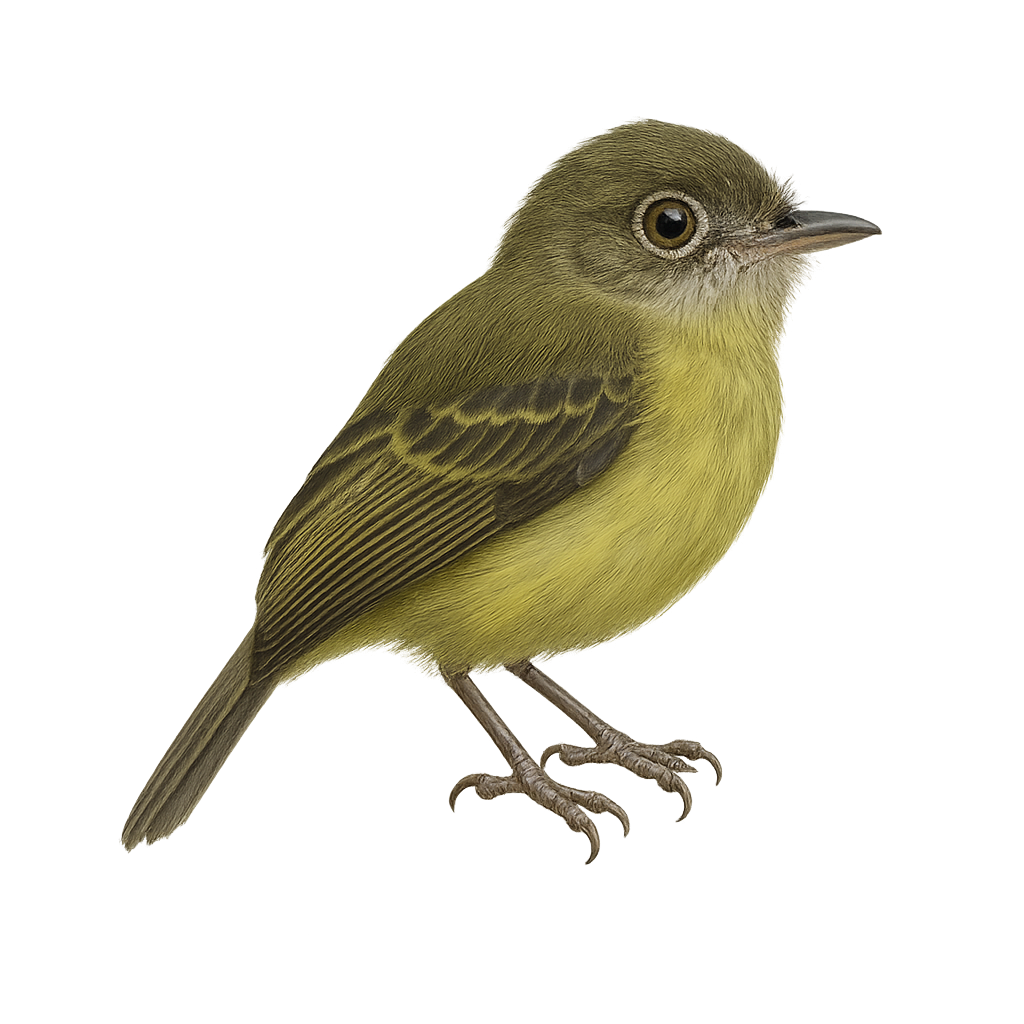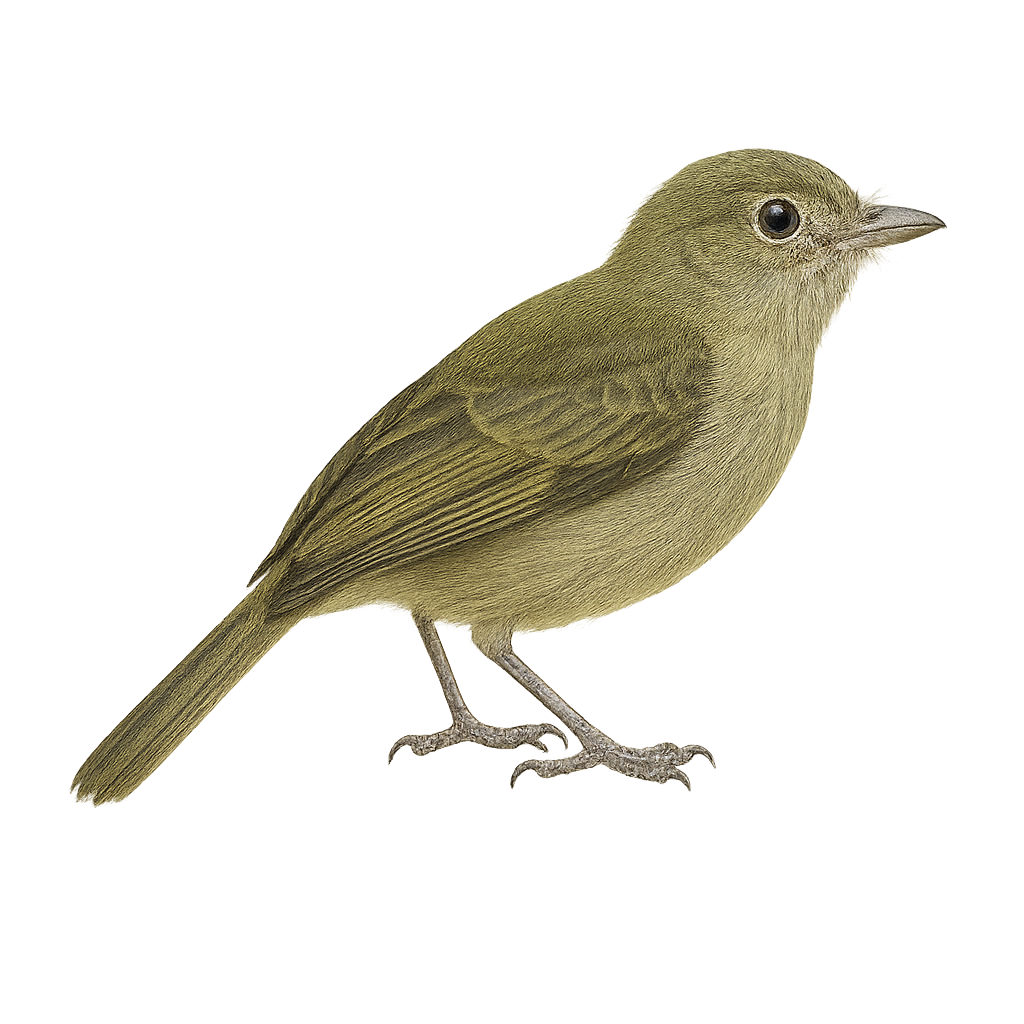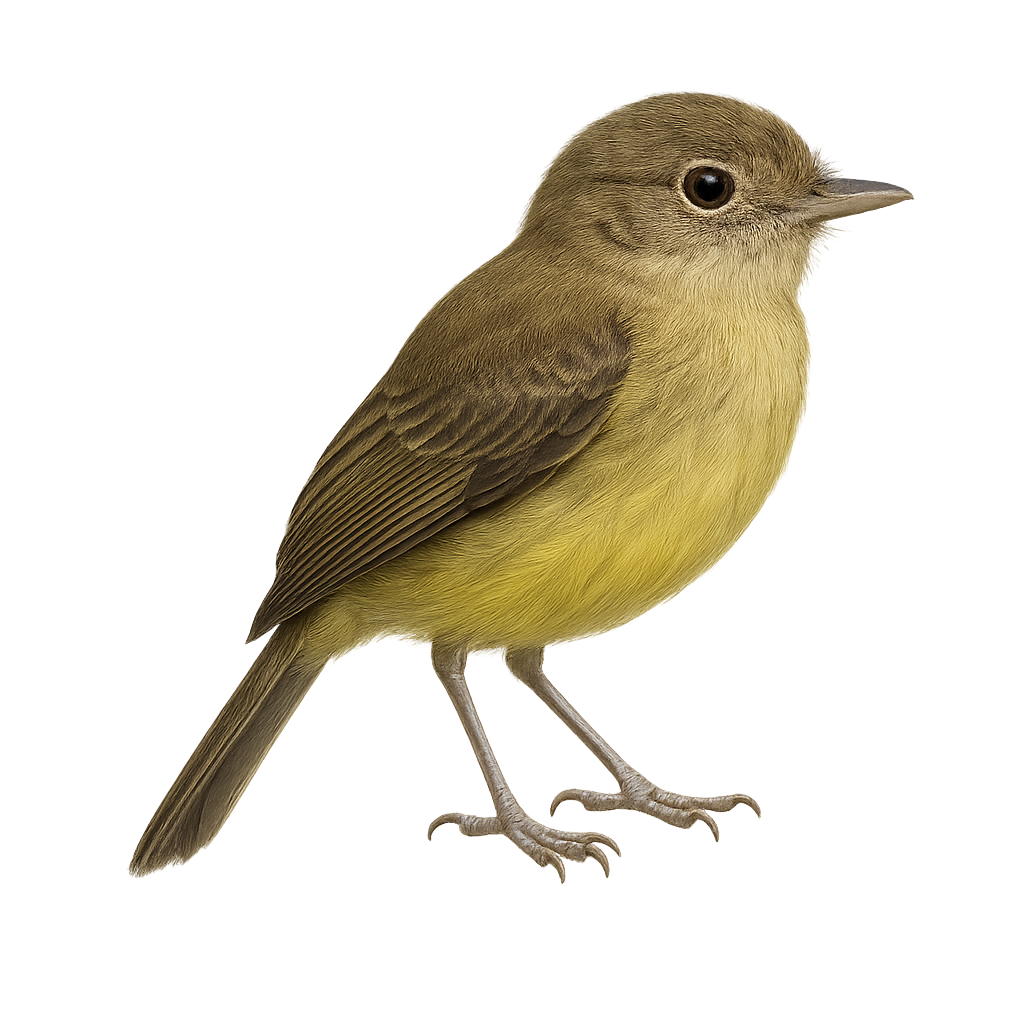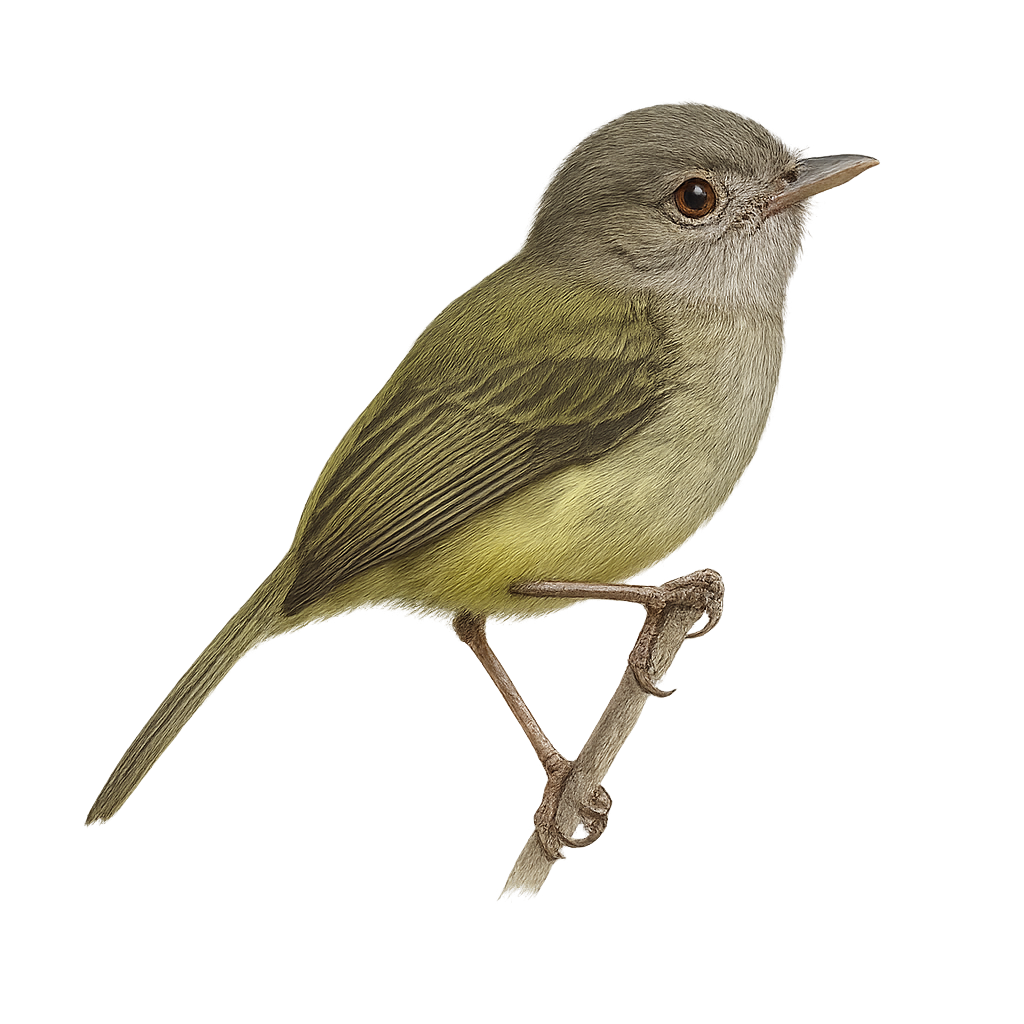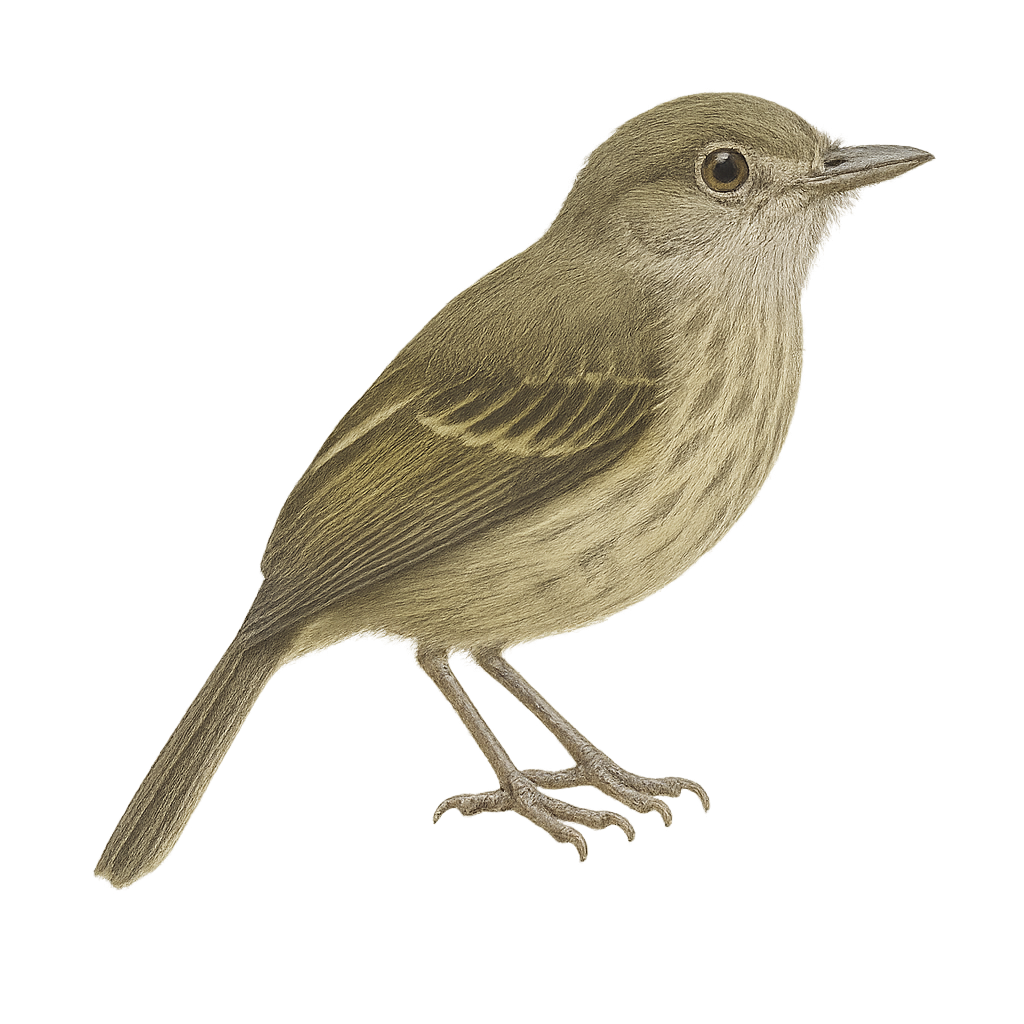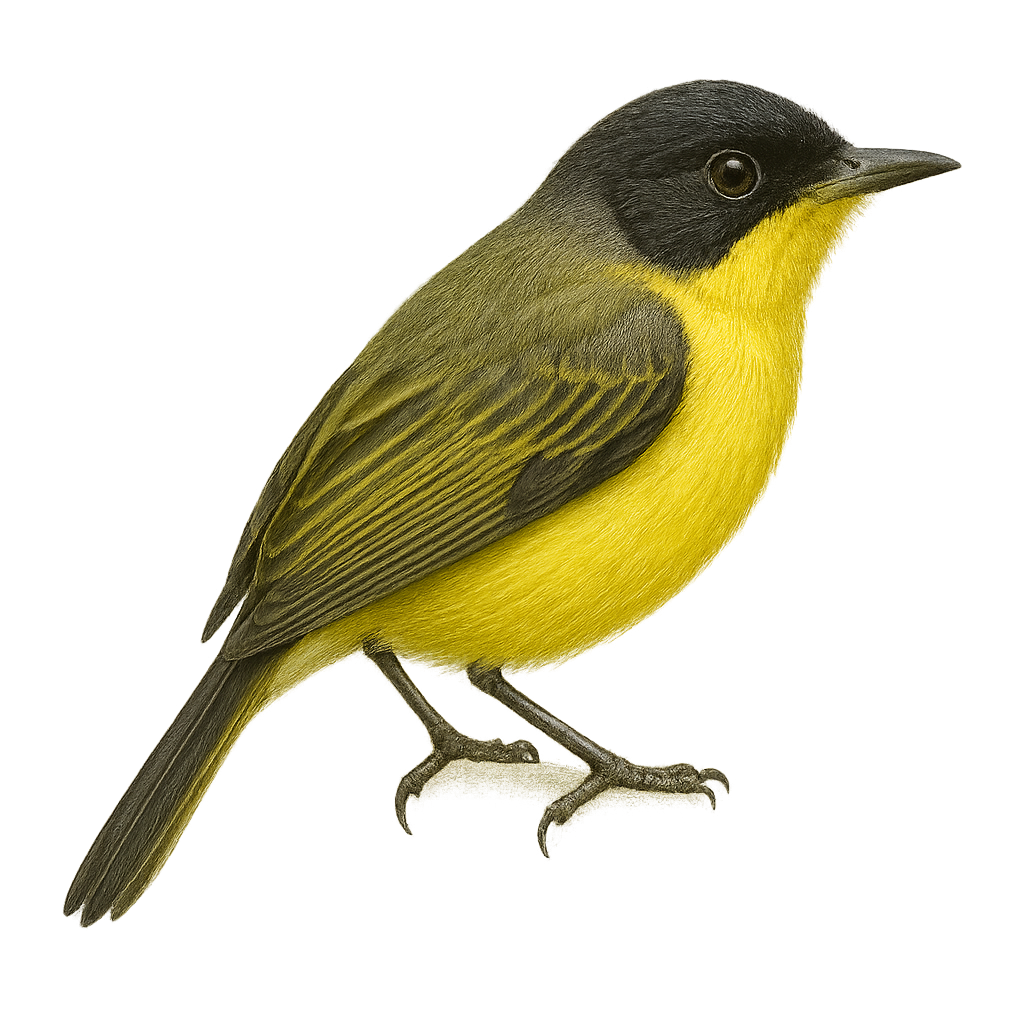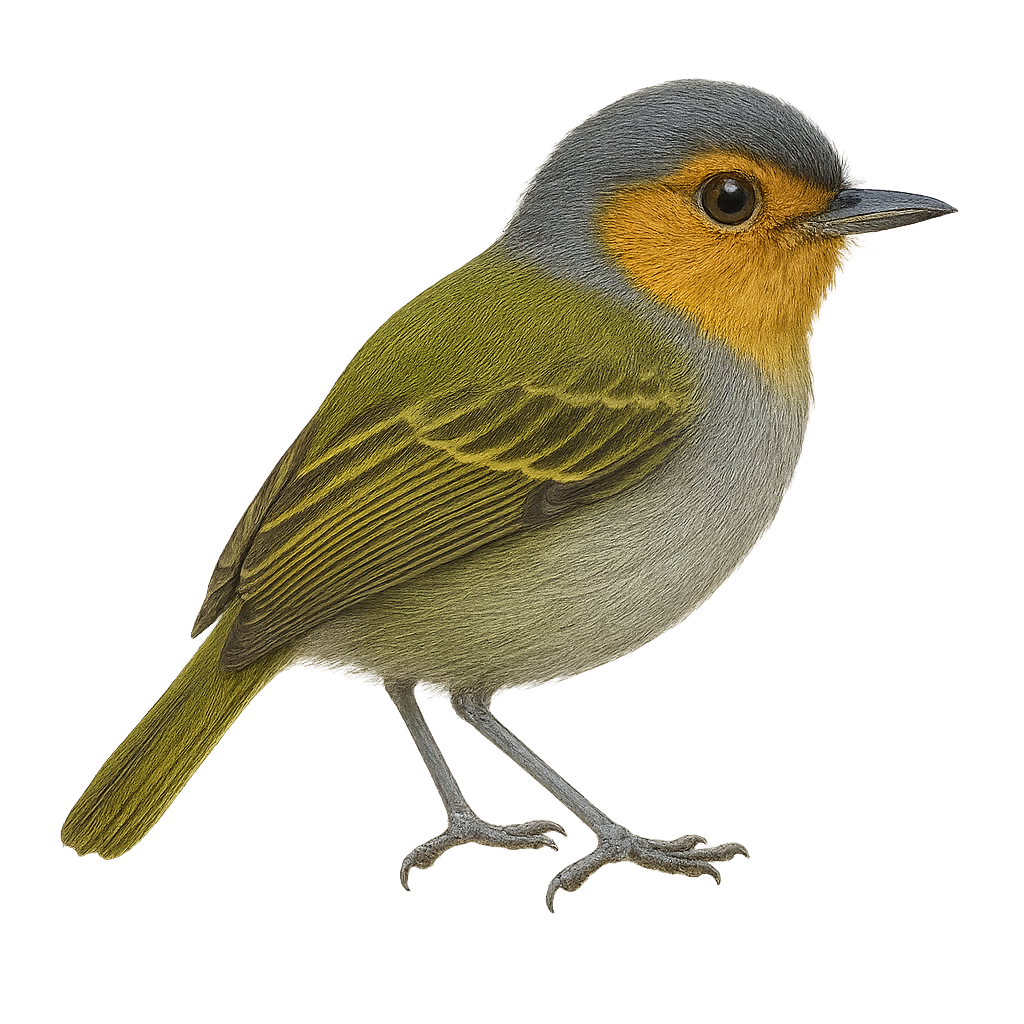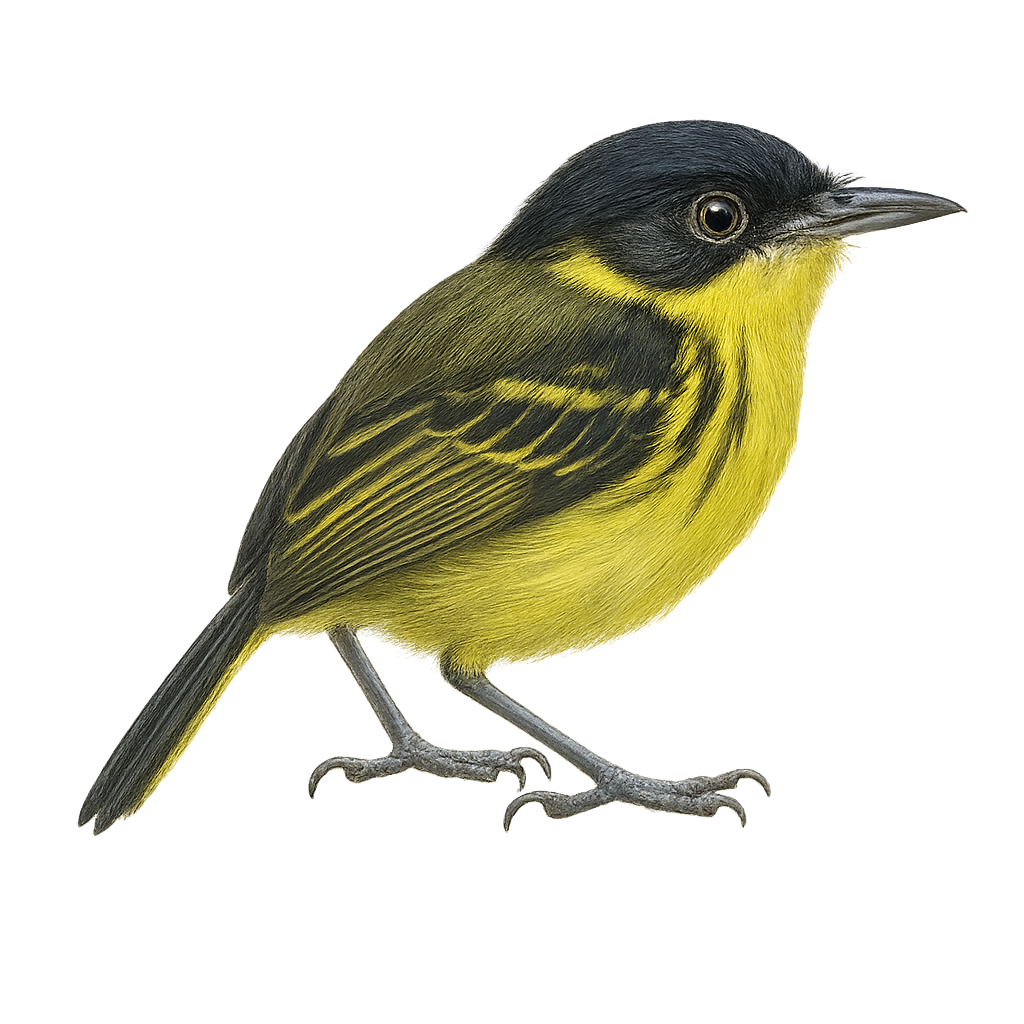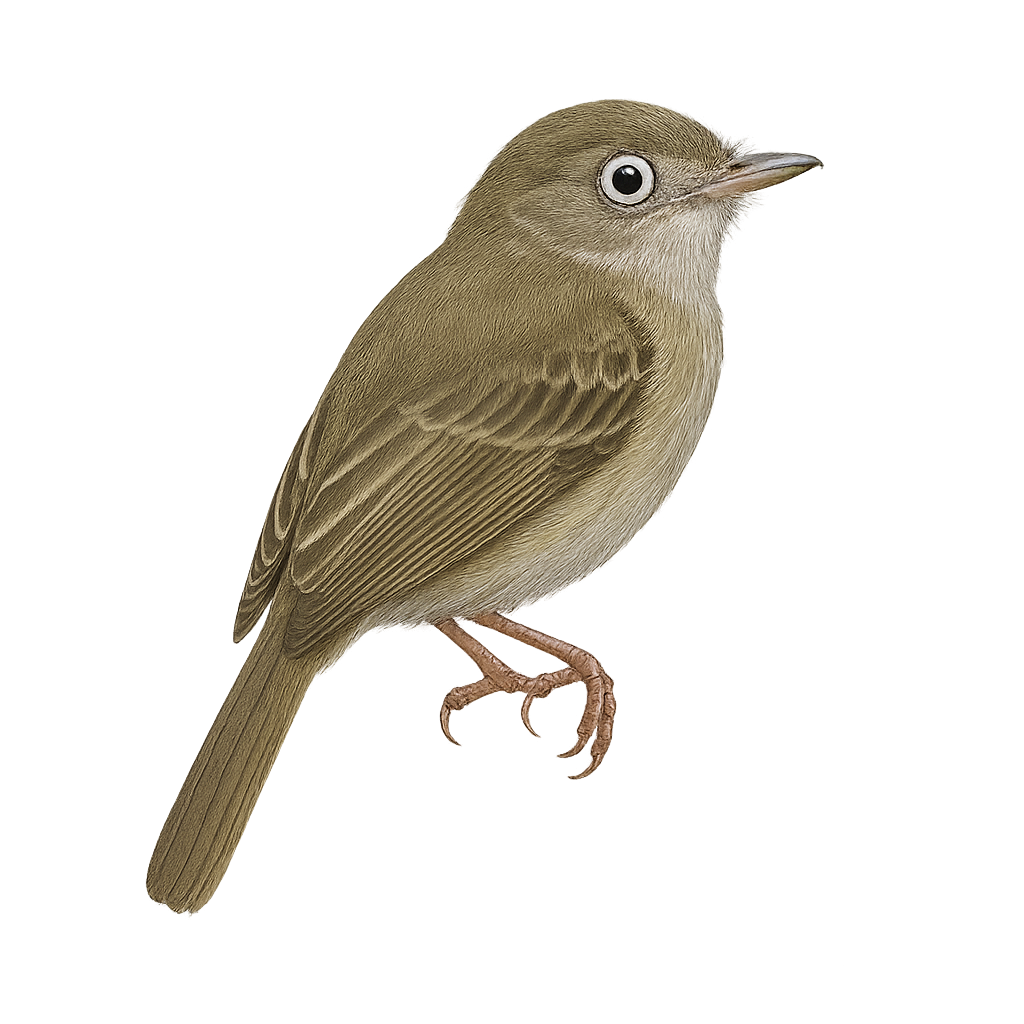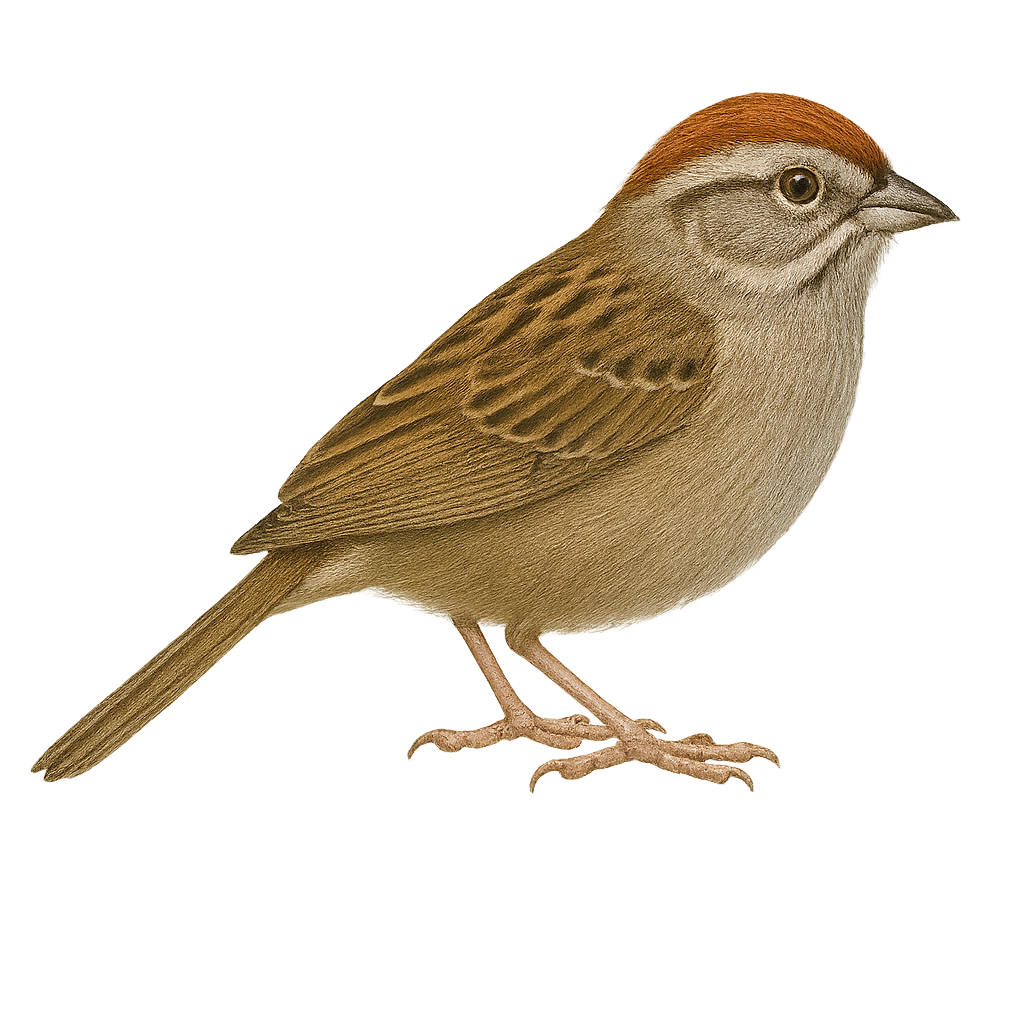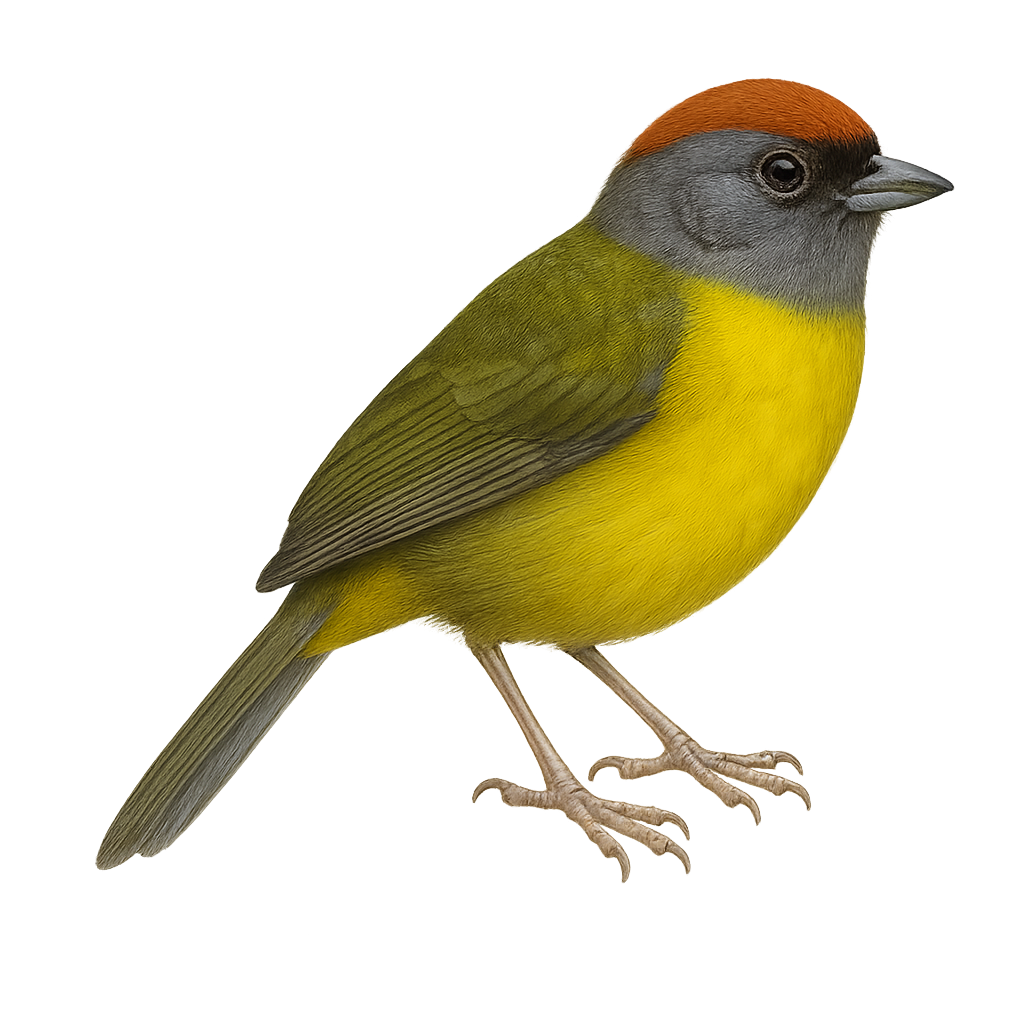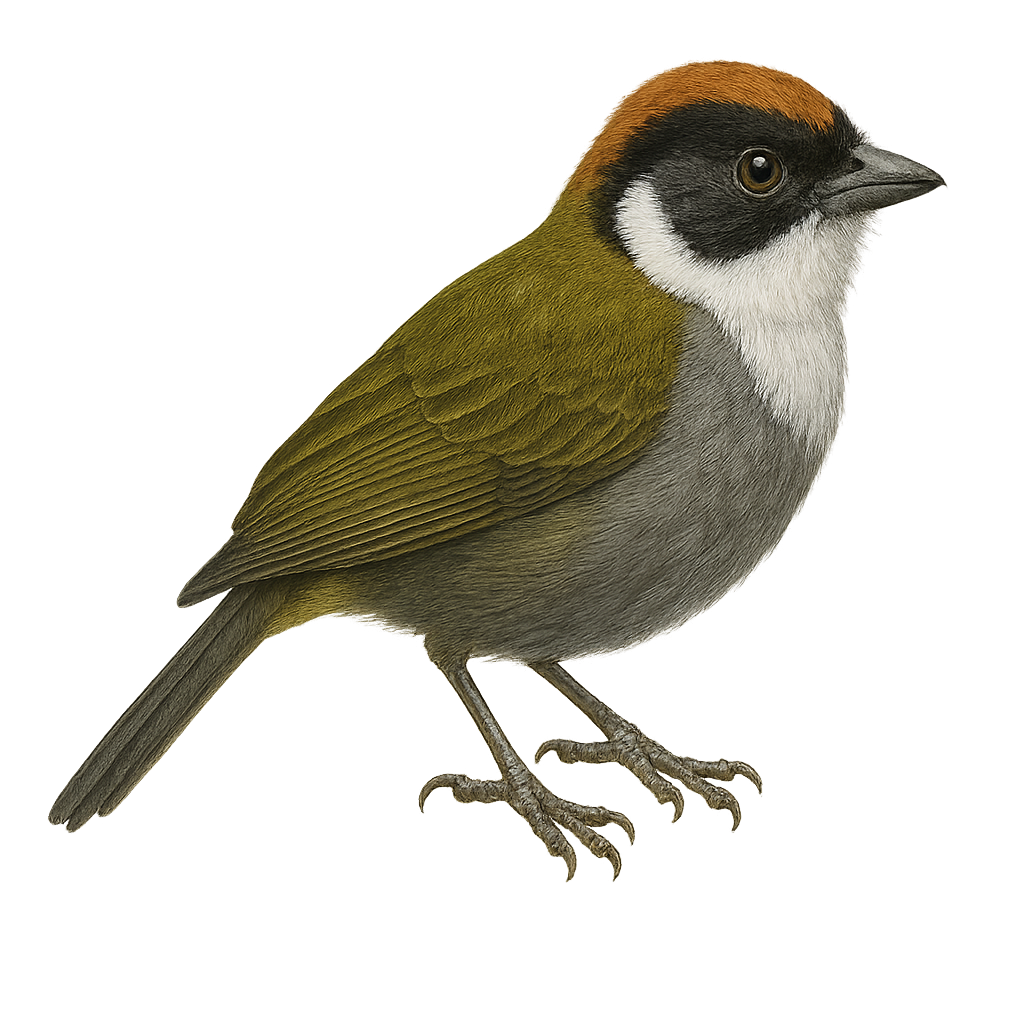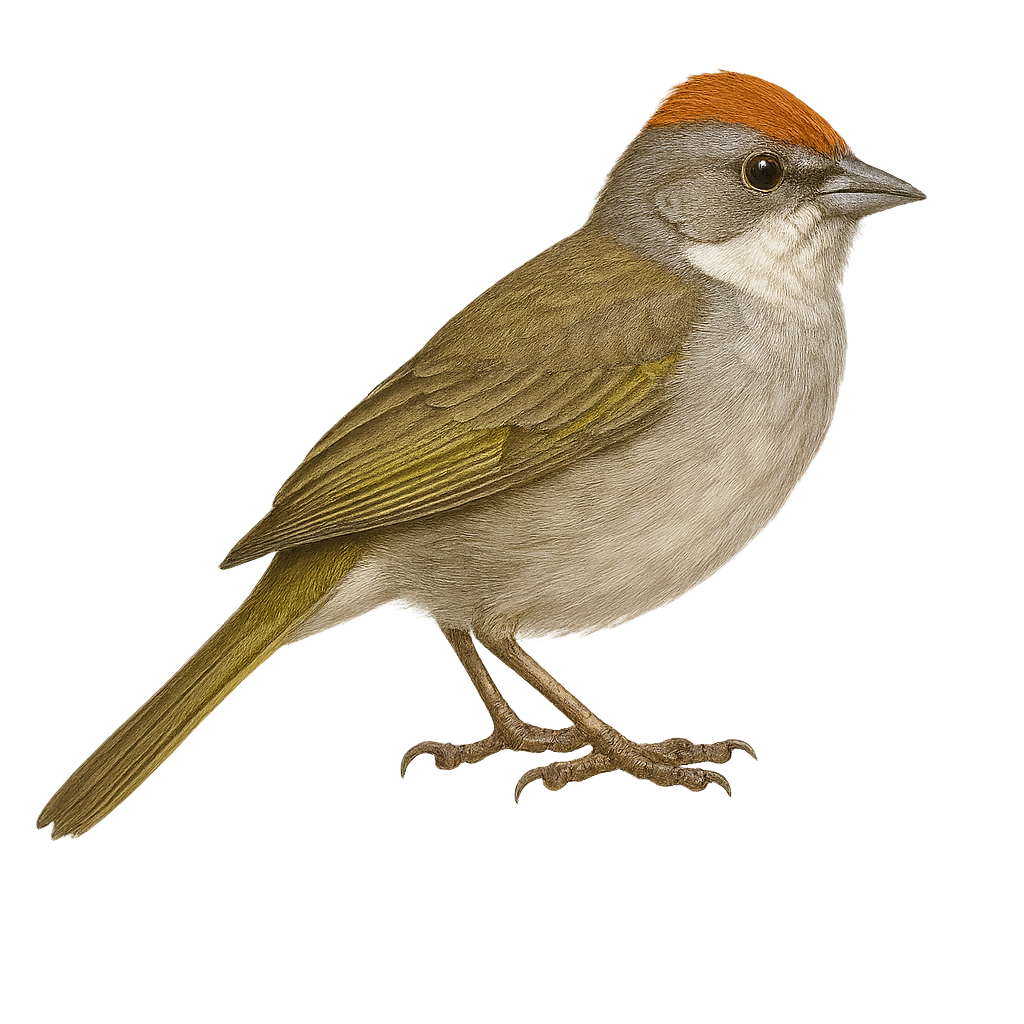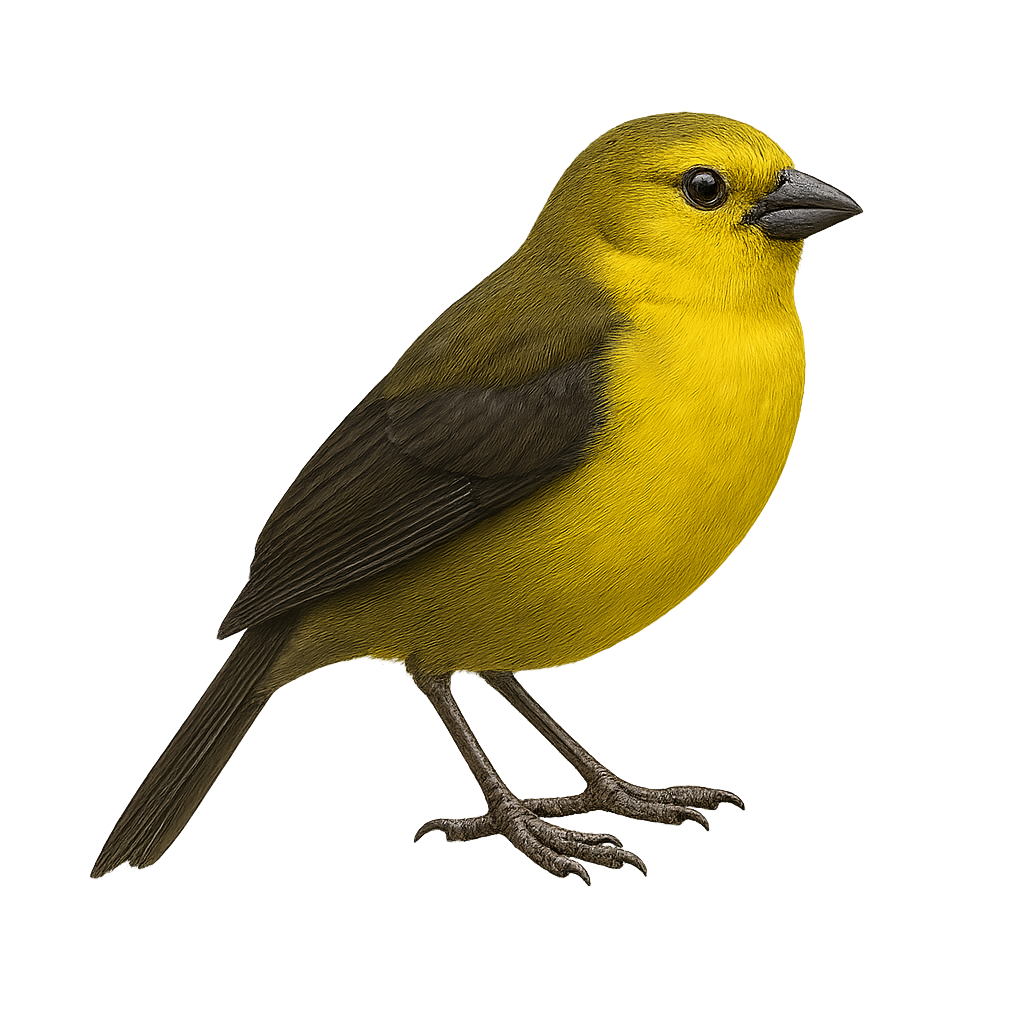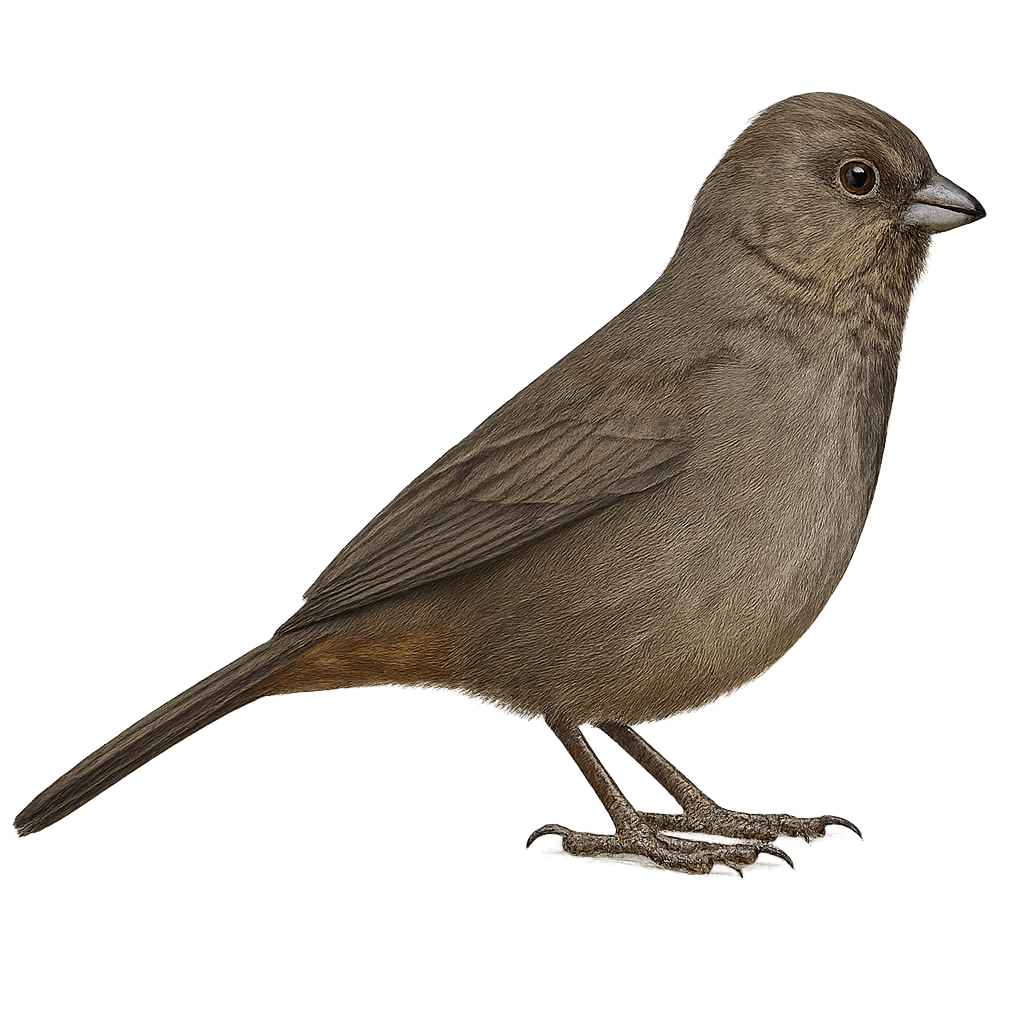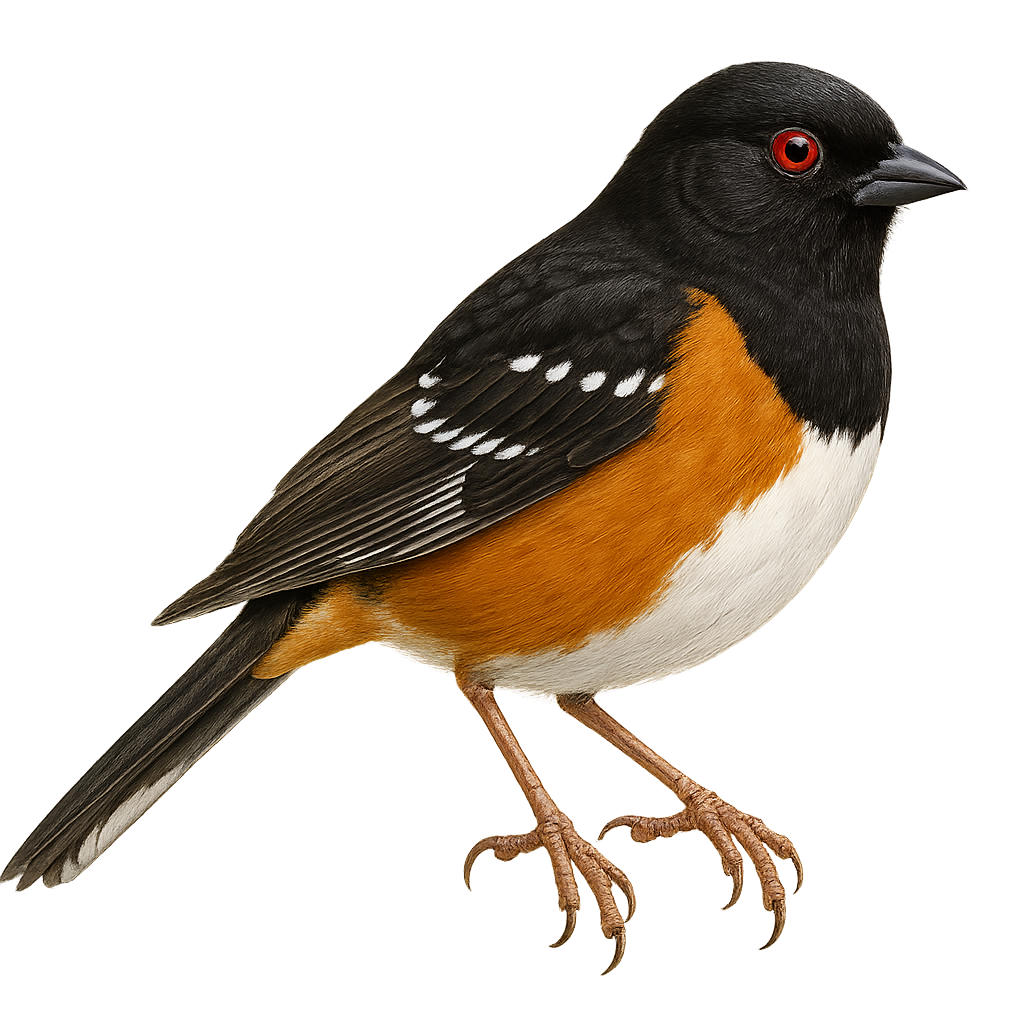The Fawn-breasted Tody-Tyrant is a small passerine bird belonging to the Tyrannidae family. It is primarily found in the tropical rainforests of South America, particularly in Brazil, Guyana, and Venezuela. This bird is characterized by its olive-green plumage on the back and pale yellow underparts, with a grayish head and distinctive fawn-colored forehead. It measures about 9 to 10 cm in length and weighs between 6 and 8 grams. It is often seen foraging for insects in dense foliage, moving with agility and speed. Its song is a soft, repetitive trill, often heard at dawn.
The Rusty-fronted Tody-Flycatcher (Poecilotriccus latirostris) is a small bird from the Tyrannidae family, commonly found in the tropical forests of South America. It is recognized by its colorful plumage, featuring a rusty head and bright yellow belly. Its relatively broad bill gives it its name. This bird is often seen catching insects mid-air or foraging through foliage. Although discreet, its melodious song often reveals its presence. It prefers dense habitats where it can easily hide. Its adaptability to various environments makes it a relatively common species within its range.
The Rufous-crowned Tody-Flycatcher, Hemitriccus rufigularis, is a small bird in the Tyrannidae family. It is notable for its distinctive rufous throat, contrasting with its olive-green plumage. This discreet bird primarily inhabits humid montane forests, often at altitudes between 1000 and 2000 meters. It is usually observed alone or in pairs, feeding on insects caught in flight or on leaves. Its song is a soft trill, often heard before the bird is seen. Although its habitat is threatened by deforestation, the species is currently classified as Least Concern by the IUCN.
The Drab-breasted Pygmy-Tyrant is a small passerine bird from the Tyrannidae family, primarily found in the humid forests and forest edges of South America. It is characterized by its dull plumage, with shades of brown and gray, and its small size, measuring about 9 to 10 cm in length. This bird is often difficult to spot due to its discreet and elusive behavior. It feeds mainly on insects, which it catches in flight or on leaves. The Drab-breasted Pygmy-Tyrant is a sedentary bird, not very migratory, preferring dense habitats where it can easily hide. Its population is stable, although deforestation may pose a potential threat to its natural habitat.
The White-eyed Tody-Tyrant is a small passerine bird belonging to the Tyrannidae family. It is notable for its distinctive white eyes, contrasting with its olive-green and yellow plumage. This bird is primarily found in the humid tropical forests of South America, particularly in Brazil, Bolivia, and Peru. It is often seen in dense undergrowth, where it feeds on insects and spiders. Its song is a high-pitched, rapid trill, often heard before it is seen. Although discreet, it is curious and can be observed at altitudes up to 1500 meters. Its population is stable, but deforestation remains a potential threat to its natural habitat.
The Black-capped Pygmy Tyrant is a small passerine bird belonging to the Tyrannidae family. It is characterized by its black head contrasting with its grayish body and slightly yellow-tinged wings. This tiny bird measures about 9 to 10 cm in length and weighs between 6 and 7 grams. It is primarily insectivorous, feeding on small insects caught in flight or on leaves. It is found in tropical humid forests, forest edges, and sometimes in open wooded areas. Its song is a high-pitched, rapid trill, often heard before being seen. It is generally solitary or seen in pairs, known for being quite discreet and difficult to spot in its dense habitat.
The Pearl-breasted Tody-Tyrant is a small passerine bird belonging to the Tyrannidae family. It is characterized by its delicate plumage, with a pearly white belly that contrasts elegantly with its generally olive-green body. This bird is mainly found in the humid tropical forests of South America, where it feeds on insects it skillfully captures. Its song is a gentle trill that resonates through the canopy. Although small, it is quite active and can be difficult to spot in its dense habitat. It plays an important role in the ecosystem by controlling insect populations and participating in the pollination of certain plants.
The Rufous-crowned Tody-Flycatcher is a small bird from the Tyrannidae family, primarily found in the humid forests and forest edges of South America. It is notable for its distinctive rufous crown, contrasting with its olive-green body and pale yellow belly. Measuring about 9 to 10 cm, this bird is agile and active, often seen catching insects in flight. Its song is a high-pitched trill, often repeated. Though discreet, it is sometimes observed in small family groups. It plays an important role in controlling insect populations, thus contributing to the ecological balance of its habitat.
The Yellow-browed Tody-Flycatcher is a small bird with distinctive plumage, primarily olive green with golden cheeks that give it its name. It inhabits the humid tropical forests of South America, particularly in the Amazon. This passerine is often seen in pairs or small groups, actively moving through the canopy in search of insects. Its song is a high-pitched, rapid trill, often heard before it is seen. Although its habitat is threatened by deforestation, it remains relatively common in protected areas. Its small size and quick movements make it difficult to spot, but it is a prized subject for birdwatchers and nature photographers.
The Yungas Pygmy-Tyrant, or Hemitriccus spodiops, is a small passerine bird belonging to the Tyrannidae family. It is primarily found in the humid montane forests of the Yungas, a region spanning Bolivia and northern Argentina. This bird is characterized by its olive-green plumage, gray breast, and distinctive white eye-rings. It measures about 10 cm in length and weighs between 6 and 8 grams. The Yungas Pygmy-Tyrant is an active insectivore, often seen alone or in pairs, darting through foliage in search of small insects. Although its habitat is relatively limited, it is not currently considered threatened, but deforestation could pose a long-term risk.
The Southern Bentbill is a small bird from the Tyrannidae family, primarily found in the tropical rainforests of Central and South America. It is characterized by its olive-green back and yellow belly, along with a short, flattened bill. This passerine is often seen foraging among dense foliage, feeding mainly on insects and spiders. Although discreet, its high-pitched, repetitive song makes it identifiable. It is usually solitary or found in pairs, and its presence is an indicator of healthy forest ecosystems.
The Johannes's Tody-Tyrant is a small passerine bird belonging to the Tyrannidae family. It is primarily found in the tropical and subtropical moist forests of South America, particularly in Brazil, Colombia, and Peru. This bird is characterized by its olive-green plumage on the back and pale yellow on the belly, with a gray head and a short, flattened bill. It is often seen actively moving through the lower branches of trees, searching for insects and spiders, which make up the bulk of its diet. The Johannes's Tody-Tyrant is a discreet bird, with a soft, repetitive trill as its song. It plays an important role in the ecosystem by controlling insect populations.
The Josephine's Tody-Tyrant is a small passerine bird belonging to the Tyrannidae family. It is primarily found in the humid tropical forests of South America, particularly in Peru, Colombia, and Brazil. This bird measures about 9 to 10 cm in length and is characterized by its olive-green plumage, pale yellow belly, and relatively short beak. It is often seen alone or in pairs, actively moving through foliage in search of insects. Although discreet, its high-pitched and repetitive song makes it easier to locate. The Josephine's Tody-Tyrant plays an important role in the ecosystem by controlling insect populations.
The Kaempfer's Tody-Tyrant is a small passerine bird belonging to the Tyrannidae family. It is endemic to southeastern Brazil, mainly in the humid forests of the state of Santa Catarina. This bird measures about 10 cm in length and is characterized by its olive-green back and yellow belly, with a gray head and a relatively broad bill. It is often seen in pairs or small groups, actively moving through the underbrush in search of insects. Its song is a soft, repetitive trill, often heard before the bird is seen. Due to deforestation, its habitat is threatened, leading to its classification as an endangered species by the IUCN.
The Miranda's Tyrannulet, or Hemitriccus mirandae, is a small passerine bird belonging to the Tyrannidae family. Endemic to Brazil, it primarily inhabits lowland humid forests. This small bird measures about 10 cm in length and is distinguished by its olive-green plumage, brown wings, and lighter belly. It is often seen foraging for food, mainly insects, in dense undergrowth. Although discreet, its high-pitched and repetitive song can be heard from a distance. The Miranda's Tyrannulet is a poorly studied species, making its behavior and biology largely unknown. However, it is considered vulnerable due to increasing deforestation in its natural habitat.
The Snethlage's Tody-Tyrant, or Hemitriccus minor, is a small bird belonging to the Tyrannidae family. It is characterized by its modest size, measuring about 9 to 10 cm in length. Its plumage is primarily olive green with lighter shades on the belly. It is mainly found in the humid tropical forests of South America, particularly in Brazil, Bolivia, and Peru. This bird is often seen in dense undergrowth, where it primarily feeds on insects. Although discreet, its high-pitched and repetitive song can be heard from a distance. The Snethlage's Tody-Tyrant is a sedentary bird, and its behavior is generally suspicious, making it difficult to observe.
The Greenish Tyrannulet, Todirostrum viridanum, is a small bird from the Tyrannidae family, primarily found in the humid forests and wooded areas of Central America. This passerine is distinguished by its olive-green plumage, dark wings, and lighter belly. It is often seen foraging for insects in dense foliage, using its short, broad bill to catch prey. Although discreet, its high-pitched, repetitive song makes it identifiable. The Greenish Tyrannulet plays a crucial role in the ecosystem by regulating insect populations and aiding in seed dispersal. Its adaptability to various habitats allows it to survive despite increasing deforestation.
The Common Tody-Flycatcher, or Todirostrum cinereum, is a small bird native to Central and South America. It is easily recognized by its gray and bright yellow plumage and its distinctive flattened bill. Measuring about 9 to 11 cm, it is often found in tropical forests, mangroves, and open wooded areas. Its song is a high-pitched, rapid trill, often heard before the bird is seen. It feeds primarily on insects, which it catches in flight or on leaves. The Common Tody-Flycatcher is a sociable bird, often seen in pairs or small groups, and is known for its curiosity towards humans.
The Plumbeous-headed Tody-Flycatcher is a small bird with a subtle plumage, mainly gray with hints of brown and white. It is often found in tropical and subtropical forests, where it primarily feeds on insects. Its modest size and discreet behavior can make it hard to spot, but its distinctive song often aids in locating it. This passerine is known for its ability to weave through dense foliage in search of food. Although usually solitary, it can sometimes be seen in small family groups. Its breeding season varies by region but is generally active during the warmer months.
The Painted Tody-Flycatcher is a small bird primarily inhabiting the humid tropical forests of South America. Its modest size, usually around 9 to 10 cm, is offset by its vibrant plumage. Males display bright colors with shades of yellow, green, and black, while females have softer hues. This bird is often seen catching small insects in flight, thanks to its slender, pointed beak. Known for its liveliness and agility, it moves swiftly between branches in search of food. The Painted Tody-Flycatcher is also recognized for its melodious songs, echoing through the dense forest canopy.
The White-eyed Tody-Tyrant, or Hemitriccus zosterops, is a small bird from the Tyrannidae family. It is primarily found in lowland humid forests in South America, particularly in Brazil, Bolivia, and Peru. This passerine is notable for its white eye-ring, which gives it its name. With a modest size of about 9 cm in length, its olive-green plumage with yellowish underparts makes it hard to spot in dense habitats. It feeds mainly on insects, which it catches in flight or on leaves. The White-eyed Tody-Tyrant is an active and vocal bird, often heard before seen. Its song is a rapid, high-pitched trill.
The Rufous-crowned Sparrow is a small passerine bird known for its distinctive rufous cap, which contrasts with its gray and brown plumage. It is primarily found in the arid and semi-arid regions of the southwestern United States and Mexico. This bird favors open habitats with sparse shrubs and rocky terrain. It is often seen foraging on the ground, feeding mainly on seeds and insects. The Rufous-crowned Sparrow is a discreet bird, often difficult to spot due to its camouflaged plumage. Its song is a soft, melodious trill, often heard in the spring.
The Rusty-capped Brushfinch, scientifically known as Atlapetes pileatus, is a passerine bird belonging to the family Passerellidae. It is primarily found in the humid montane forests and wooded areas of Mexico and Guatemala. This bird is notable for its varied plumage, with a distinctive rusty cap that gives it its name. Its chest is often pale gray, while its wings and back display shades of brown and olive green. The Rusty-capped Brushfinch is a discreet bird, often seen in small groups or pairs, feeding mainly on insects and fruits. Its melodious and varied song is a delight for birdwatchers.
The Chestnut-capped Brushfinch is a medium-sized bird known for its distinctive chestnut-brown cap, contrasting with its olive-green back and gray belly. It also features a black stripe across its eyes, adding to its unique appearance. This bird is primarily found in the humid forests and dense undergrowth of Central America, where it feeds mainly on insects and seeds. Although discreet, it is often detected by its melodious song. The Chestnut-capped Brushfinch is a sociable bird, often seen in small groups or pairs. Its ability to adapt to various forest habitats makes it a common resident within its range.
The Grünschwanz-Grundammer is a medium-sized bird, measuring about 18 to 20 cm in length. It is easily recognizable by its olive-green back, gray chest, and distinctive rufous crown. This bird prefers shrubby habitats and dense undergrowth, often in mountainous regions of western North America. It is primarily granivorous but also consumes insects, especially during the breeding season. The Grünschwanz-Grundammer is a discreet bird, often heard before seen, thanks to its melodious song and distinctive calls. Although generally solitary, it can be observed in small groups during migration.
The Yellow-headed Brushfinch, Atlapetes flaviceps, is a bird endemic to Colombia, primarily found in montane humid forests. It is distinguished by its bright yellow head contrasting with its grey and black body. This species prefers dense undergrowth where it feeds on fruits, insects, and seeds. Although discreet, the Yellow-headed Brushfinch is often detected by its melodious song. Unfortunately, deforestation threatens its natural habitat, classifying it as a vulnerable species. Conservation efforts are crucial for its survival. Ornithologists and bird enthusiasts particularly appreciate its beauty and intriguing behavior, although it can be challenging to observe due to its wary nature.
The Canyon Towhee, or Melozone fusca, is a medium-sized bird known for its distinctive brown cap and gray-brown plumage. It is primarily found in the arid and semi-arid regions of the southwestern United States and Mexico. This bird prefers shrubby habitats and dense underbrush areas where it can forage for seeds, insects, and small invertebrates. Although often discreet, it can be identified by its melodious song and distinctive calls. The Canyon Towhee is a sedentary bird, meaning it does not migrate over long distances. It is usually observed alone or in pairs, especially during the breeding season.
The Olive Sparrow, Arremonops rufivirgatus, is a small passerine bird belonging to the Passerellidae family. It is primarily found in wooded and shrubby areas of southern Texas and northeastern Mexico. Its plumage is mainly olive with shades of brown, allowing it to blend seamlessly into its natural surroundings. The Olive Sparrow is a discreet bird, often heard before being seen, thanks to its distinctive and repetitive song. It primarily feeds on seeds and insects found by foraging on the ground. Although relatively common within its range, it remains difficult to spot due to its discreet behavior and dense habitat.
The Rusty Sparrow is a small passerine bird belonging to the Passerellidae family, primarily found in the mountainous regions of Central America. It is characterized by its reddish-brown plumage, white throat, and distinctive wing patterns. This bird prefers dry forests, scrublands, and open shrub areas. It is often seen foraging on the ground, feeding mainly on seeds, insects, and small invertebrates. The Rusty Sparrow is known for its melodious and varied song, which it uses to mark its territory and attract a mate. Although generally discreet, it can be spotted by its distinctive song.
The Spotted Towhee is a medium-sized bird known for its distinctive plumage. Males have a black back, rufous sides, and a white belly, while females are browner. They are often found in dense underbrush and shrubs, feeding mainly on insects and seeds. Their song is a vibrant trill, often heard in spring. Although generally solitary, they can sometimes be seen in small groups. Their behavior is somewhat suspicious, but they can become more tolerant in areas frequented by humans.


